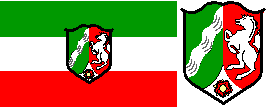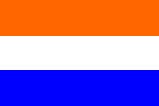- PIERCED
- The heraldic term for when a charge (such as a quatrefoil or mullet) has a hole in its centre
(see also quatrefoil 2,
star 2) and
voided).

- PIGSTICK
- See truck 2).
- PIKE
- In British and some other military usage the staff upon which an infantry
colour is carried (see also 'colour 2)',
colours 2) and
staff 2)).
Please note that the term is derived from the long-shafted
spear with which a proportion of infantry were formerly armed, and whilst the
term is still applied, the staff may often no longer have a spear point, but may
carry a finial of some other design.
- PILE
- 1) On flags, a triangular charge whose base generally occupies the full length
or width of a flag, and whose apex touches the centre of its opposite edge. When
the apex is on the fly it may be called a simple pile, with the apex on the hoist
a reversed pile, with the apex on the top edge an upright pile and with the apex
on the bottom edge of the flag an inverted pile (see also
reversed,
triangle) and
upright).
- 2) In heraldry, an elongated triangular charge of no specific width (although
it is sometimes stipulated that the pile should be one-third the width of the
shield or banner of arms) and is generally (although not invariably) placed with
the point downwards.
|
![[flags with pile]](../images/v/vxt-d243.gif)
National Flag of Eritrea (fotw) |
![[flags with pile]](../images/v/vxt-d243a.gif)
Flag of Houvet, Belgium (fotw)
|
![[flags with pile]](../images/v/vxt-d243b.gif)
National Flag of Antigua-Barbuda (CS)
|
![[pile]](../images/v/vxt-d243c.gif)
|
Please note, however, that
on flags a pile whose apex and base do not touch opposite edges of the flag should
be considered a triangle (see also triangle).
- PILGRIMAGE PENNANT (or FLAG)
- A small triangular pennant, or occasionally a handwaver size flag, purchased as the souvenir
of a spiritual (usually Roman Catholic) pilgrimage, religious festival or special place of
worship, and often made from paper (see also handwaver).
- PILOT FLAG
- That flag which is flown by a vessel requiring or carrying a pilot, now
either G for Golf (if requiring a pilot) or H for Hotel (if under pilotage)
from the International Code of Signal Flags (see also
International Code of Signal Flags and
signal flag).
![[pilot flags]](../images/v/vxt-d247.gif)
From left: Signal Flag Golf (CS); Signal Flag Hotel (CS); Former
Pilot Flag of Belgium (CS)
Please note however, that many countries originally
had their own designs for pilot flags, of which the UK version - that is the national
flag with a white border - is typical of the type and a rare survival (see civil
jack under jack and
pilot jack). See supplemental note:
- PILOT JACK
- In UK usage, originally a name for the national pilot flag, now an alternative
name for the civil jack (see civil jack under
jack, pilot flag and
union jack).
![[a pilot jack]](../images/v/vxt-d245.gif)
UK Pilot Jack (fotw)
- PINSEL (or PINCEL)
- A triangular pennant used by the authorized representative of a Scottish clan
chief in that persons absence. It has a solid field and is 0.60 x 1.35m long,
it is generally charged with the grantees crest within an annulet or ring (surmounted
by a coronet or bonnet dependent upon rank), and the grantees motto (see also
annulet and
ring).
- PIPE BANNER
- See bannerette.
- PIRATE FLAG
- See 'jolly roger'.
- PLAIN
- 1) See undefaced.
- 2) On flags, the term that is applied to a flag which has monochrome field, or to
a bicolour, tricolour, triband or multi-stripe which carries no charges other than its
stripes, or to an undecorated border consisting of a single colour (see also
bicolour 1) & 2),
border,
charge 1) & 2),
multi-stripe 1) - 4),
triband 1) & 2) and
tricolour 1) & 2)).
- 3) In heraldry the term is sometimes used to describe a simple charge when it is
displayed in the same quarter of a coat of arms with another which is decorated or in
some way altered for example a plain chevron may be surrounded by an engrailed border
(see also bordure,
charge 1),
coat of arms 2),
chevron 1),
engrailed and
quarter 2)).
- POINTED (or POINT-IN-POINT)
- A heraldic term for when the division of a shield forms a chevron usually with curved sides -
at its base - point in point or enty (see also
base, chevron 1)and
shield 1))

Flag and Arms of North Rhine Westphalia, Germany (CS)
- POLE
- See flag pole.
- POLE MAST
- A flagpole that is straight and clear of any projections such as cross bars,
yards, or gaffs (see also cross bar,
flag pole,
gaff and yard).
Please note that this term was originally introduced
to describe a mast or masts on those steam vessels not equipped with an auxiliary
sailing rig.
- POLITICAL FLAG
- 1) The flag, either official (formally adopted) or unofficial (spontaneously
displayed by supporters), of a political party or movement (see also
"tribal flag).
- 2) A flag, as opposed to a banner as defined herein, that is specifically
designed to express a political or popular sentiment - a protest flag (see also
banner 3)).
![[political flags]](../images/v/vxt-d248.gif)
![[political flags]](../images/v/vxt-d248a.gif)
From left: African National Congress, RSA; American Indian Movement, USA; Communist Party, UK;
Polish Independence Movement Solidarity 1980s (fotw)
- PORT EPEE
- See dress knot.
- PORTOLANO
- The term for a navigational chart of the 14th to the 16th Centuries, particularly showing
coastlines and ports and usually bearing illustrations of their arms and flags.
- POSITION OF HONOUR (OR HONOR)
- The position in which the most senior flag, emblem or coat of arms usually
a national flag, emblem or coat of arms - is to be placed. The particulars vary
slightly in detail, legal status and extent from country to country; however,
the general principles remain the same and are listed in
Appendix II (see also
rules of etiquette and
precedence).
- POSITIONAL FLAG
- 1) In US army usage, that flag which corresponds to a particular position
held, rather than to the rank of the officer who currently holds it but see
appointment flag (also
rank flag 1)).
- 2) See distinguishing flag 1).
![[positional flag example]](../images/v/vxt-d249.gif)
Army Surgeon General, US (fotw)
- POST FLAG
- 1) In US military usage, that size of national flag flown regularly over army
posts - 10 feet (3 m) wide by 19 feet (5.8 m) long (see also
garrison flag,
storm flag and
war flag).
- 2) See postal flag below.
- POSTAL FLAG (or ENSIGN)
- The distinguishing flag of a countrys postal services a mail flag or post
flag (see also mail pennant).
![[postal flag - Denmark]](../images/v/vxt-d251.gif)
Postal Flag and Ensign of Denmark (fotw)
- POSTAL (or POSTAL) PENNANT
- See mail pennant.
- POSTURES
- A 16th/17th Century term for the formal flag waving expected of a colour bearer
for reasons of either bravado or dignity (see also
colour 2),
colour bearer,
company colours,
ensign 4),
flag tossing and
stand 1)).
- POW-MIA (PRISONER OF WAR-MISSING IN ACTION) FLAG
- See memorial flag 2).
- PRATIQUE FLAG
- See quarantine flag.
- PRAYER FLAG
- A small flag, often used in groups and decorated with inscriptions, intended
to express a prayer as it flies characteristic of Buddhists in the Himalayan
region (see also thangka and
religious flag).
- PRECEDENCE
- The system often regulated by law, of placing flags, emblems or coats of arms
for a display or ceremony in order of importance for more details see
Appendix II,
rules of etiquette and
position of honour (also
flag code and
flag law).
- PRE-HERALDIC
- A term that relates to European flags which do not contain any elements derived
from heraldry and/or which pre-date the introduction of heraldic symbolism. (see also
anti-heraldry,
dragon flag,
flammula 2),
gonfanon and
heraldry).
- PRESIDENTIAL (or PRESIDENTS) COLOUR (or COLOR)
- 1) See colour 2) and
colours 2).
- 2) In largely US usage, a term for the distinguishing flag of a president
when displayed indoors or on parade (see
presidential standard below).
- PRESIDENTIAL STANDARD (or FLAG)
- That flag which symbolizes the office of president in a republican system
of government, often a defaced or decorated version of the national flag (see
also deface,
national flag and
royal standard).
|
![[presidential standards]](../images/v/vxt-d253.gif)
USA Presidential Standard (fotw)
|
![[presidential standards]](../images/v/vxt-d253a.gif)
Chile Presidential Standard (fotw)
|
- PRINCELY BONNET (CORONET or HAT)
- See coronet 2).

National Flag of Liechtenstein bearing a Princely Bonnet (fotw)
- PRINCEFLAG (PRINCE FLAG, PRINCES FLAG, PRINSENVLAG or PRINZENVLAG)
- The name originally applied to the orange-white-blue horizontal tricolour that was the first
pattern of Dutch national flag, the driekleur, and in use from c1575 c1654/1660 the prinsenvlag
or prinzenvlag (see also
double-prince,
triple-prince and
tricolour 3)).

National Flag of the Netherlands c1575 c1654/1660 (CS)
Please note, evidence indicates that until the late 18th
Century the terms prinsenflag or prinzenvlag were sometimes also applied to the
red-white-blue tricolour.
- PRIVATE SHIP
- In British RN and some other naval usage, a vessel in commission that does
not fly the flag of a flag officer or broad pennant of a commodore (see also
broad pennant,
flag of command,
flag officer,
flagship and
masthead pennant 1)).
- PRIVATE SIGNAL
- 1) See call sign and
call sign hoist.
- 2) See house flag 3).
- 3) A naval term, now obsolete, for a confidential signal used by ships of
the same navy to verify each other's identity (see also
make her number).
- PRIVATEER JACK
- In UK usage, a special jack for vessels engaged in privateering and flown
from 1694 until 1856 the distinction jack
or budgee jack (see also
budgee flag,
budgee pendant,
jack and
union jack 2)).
![[privateer jack]](../images/v/vxt-d255.gif)
Privateer Jack Until 1801, UK (CS)
- PRIZE FLAG
- A special flag flown by a yacht that has won a race (see also
racing flag).
- PROCESSIONAL BANNER
- See banner 3).
- PROPER
- (adj) A heraldic term for an object - a plant or animal for example that
is shown in its natural form and colours as opposed to being stylized (see also
Appendix IV).
- PROPORTIONS
- 1) The relationship between the width and length of a flag, usually expressed
in that order that is, for example 1:2, but sometimes also in the reverse or 2:1
(see also dimensions',
length and
width)
- 2) The relative dimensions of two or more stripes or bands within a flag,
(whether disposed vertically horizontally or diagonally) - internal proportions
(see also optical proportions and
stripe).

- PROTEST BANNER
- See banner 3) (also
political flag 2)).
- PROTEST FLAG
- See political flag 2).
-
- PROVINCIAL FLAG
- See sub-national flag and
state flag 2).
- PSEUDO-FLAG
- See fictitious flag (also
flagoid and
fictional flag).
- PULLDOWN (or PULL-DOWN)
- In US usage a flag (or bunting in flag colours) that is displayed flat against
a wall for decoration - an advertising pulldown (see also
bunting 2).
- PULLEY
- See sheaved block.
- PURPURE
- A heraldic term for the colour purple (see also
Appendix III and
rule of tincture).
- PUSHPIT FLAG STAFF
- A 19th Century term, now almost certainly obsolete, for the stern mounted ensign staff
of a sailing yacht (see also ensign staff).
Please note that pushpit (also called a stern pulpit) is nautical
slang for that railing which encloses the stern of a sailing yacht.
![[pilot flags]](../images/v/vxt-d247.gif)
![[political flags]](../images/v/vxt-d248.gif)
![[political flags]](../images/v/vxt-d248a.gif)




![[flags with pile]](../images/v/vxt-d243.gif)
![[flags with pile]](../images/v/vxt-d243a.gif)
![[flags with pile]](../images/v/vxt-d243b.gif)
![[pile]](../images/v/vxt-d243c.gif)
![[a pilot jack]](../images/v/vxt-d245.gif)

![[positional flag example]](../images/v/vxt-d249.gif)
![[postal flag - Denmark]](../images/v/vxt-d251.gif)
![[presidential standards]](../images/v/vxt-d253.gif)
![[presidential standards]](../images/v/vxt-d253a.gif)
![[privateer jack]](../images/v/vxt-d255.gif)
